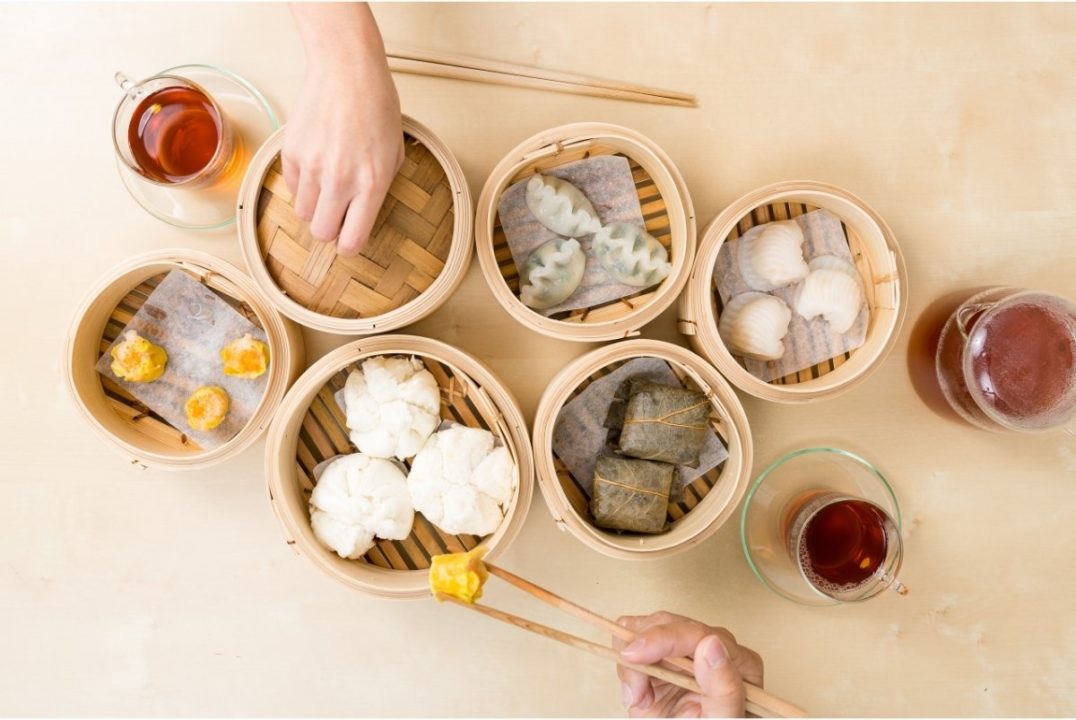With up to 15,000 restaurants jam-packed into this gem of a city, Hong Kong is the ultimate foodie paradise. The large selection of restaurants cater to any budget, hence this city is known as Gourmet Paradise and the World’s Fair of Food. Whether you’re on the hunt for authentic local street food or Michelin Star restaurants, here are some suggestions on famous Hong Kong foods to look out for.
BBQ Pork Buns (char siu bao, 叉燒包)
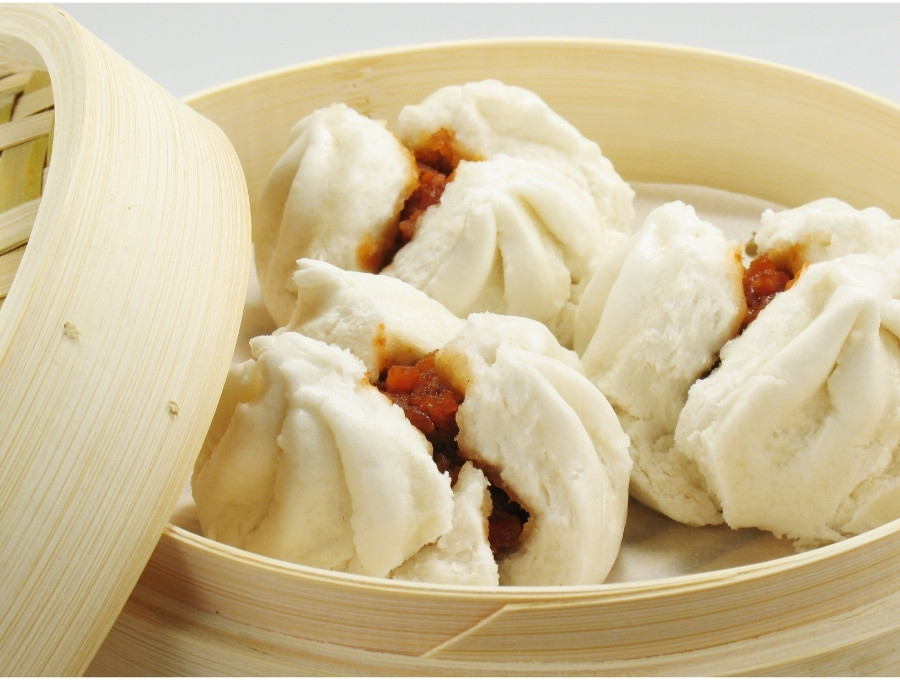
BBQ pork buns are a popular dim sum staple and can also be found in Chinese bakeries. Char siu refers to the filling, while bao means bun. The filling consists of slow roasted pork diced and mixed in a salty, syrupy red mixture, giving this savoury treat a sweet twist. There are two popular types of BBQ pork buns – steamed or baked. Steamed pork buns have a white, fluffy exterior while baked pork buns are browned and then brushed with a sweet glaze straight out of the oven. Both are equally good!
BBQ Pork Rice (char siu fan, 叉燒飯)
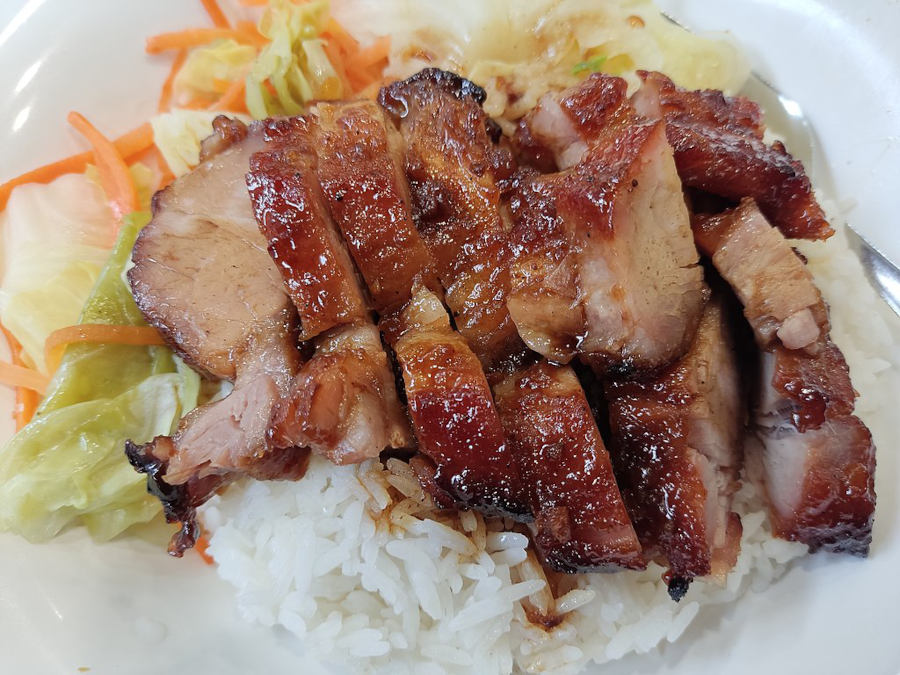
The literal translation of char siu is fork roasted, referring to the tradition of skewering seasoned meats and placing them in an oven or over a fire. Chinese BBQ pork is a delicate balance of sweet and savoury. The marinated pork is roasted until the meat is tender and the fat just melts in your mouth. The sugar crystalizes and causes the surface of the fatty meat to char, giving it its iconic smokey sweet taste. This iconic Hong Kong delicacy is paired with fluffy white rice to balance out the meat’s richness. If you’re more health conscious, request for a leaner cut, however, in our opinion, the fatty bits are the best part!
Beef Brisket Noodles (ngau lam mein, 牛腩麵)
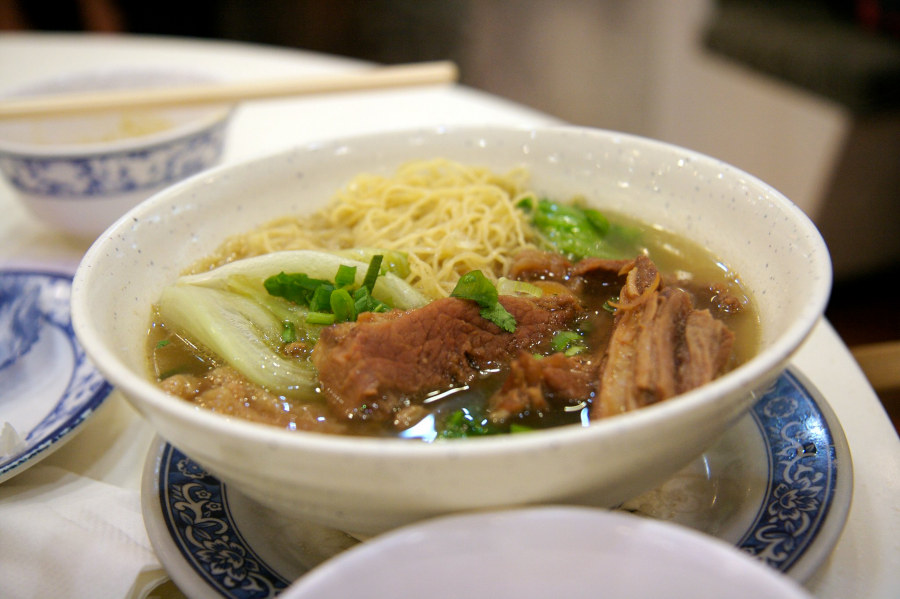
Beef brisket noodles are a staple meal in Hong Kong throughout the year. This humble dish consists of three main components – beef brisket, noodles, and broth. The beef brisket is marinated and stewed for a long period of time and served on top of wheat noodles and a clear bowl of broth. Each restaurant has its own secret blend of spices to get the tender cuts and aromatic broth associated with the ubiquitous Hong Kong dish.
Borscht (Hong Kong-Style) (luo song tang, 羅宋湯)
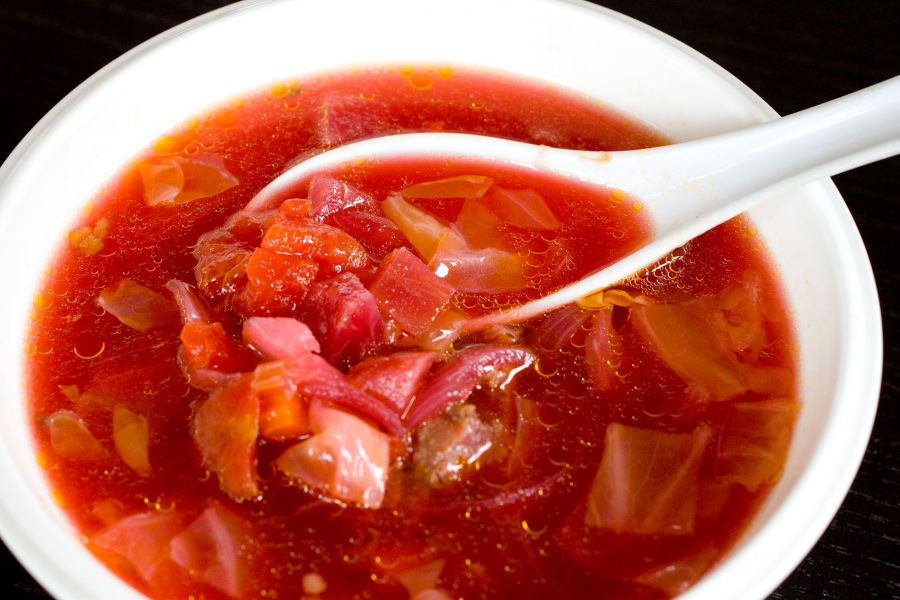
Borscht is a popular ‘soup of the day’ option in most local restaurants. There’s usually a choice between this soup, which has Western origins, and a more traditional Chinese soup. Fun fact, borscht is a staple Eastern European dish that was brought into Hong Kong following the migration of Shanghainese after World War II. Here’s Hong Kong’s unique take on this foreign dish: beets and cream are replaced with beef broth and vegetables, such as cabbage and carrots, to suit local tastebuds.
Bubble Tea (zan zyu naai caa, 珍珠奶茶)
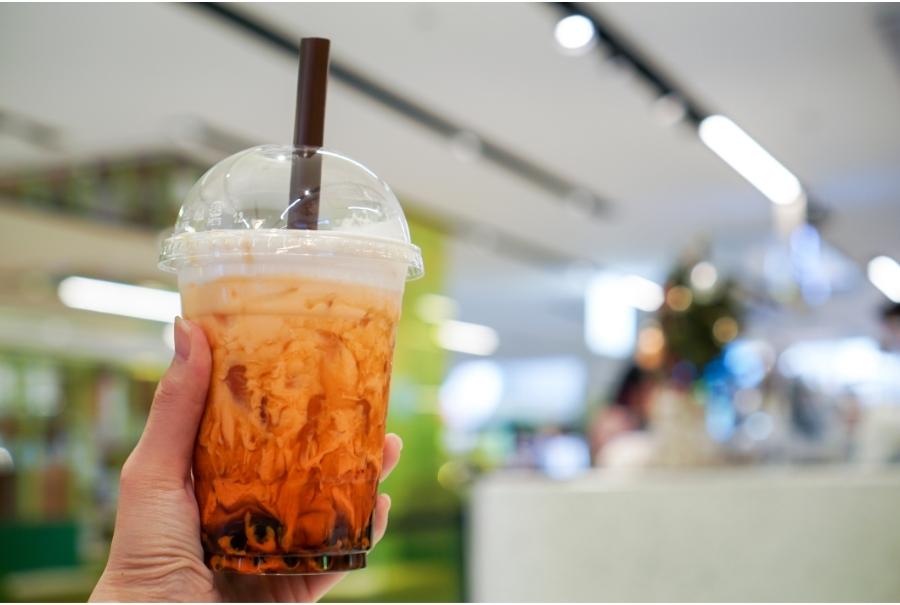
Originating from Taiwan, bubble tea has garnered a cult-like following in Hong Kong. Bubble tea or boba is a tea-based drink with fruit or more milky variations, accompanied by chewy tapioca balls. Bubble tea menus have become increasingly extensive over the years, with a creative blend of flavours and toppings like cubed fresh fruit or cookie crumbs. Whether you’re looking to try their classics, something more fruity, or a creamy treat, there’s a drink for every occasion!
Cart Noodles (ce zai min, 車仔麵)
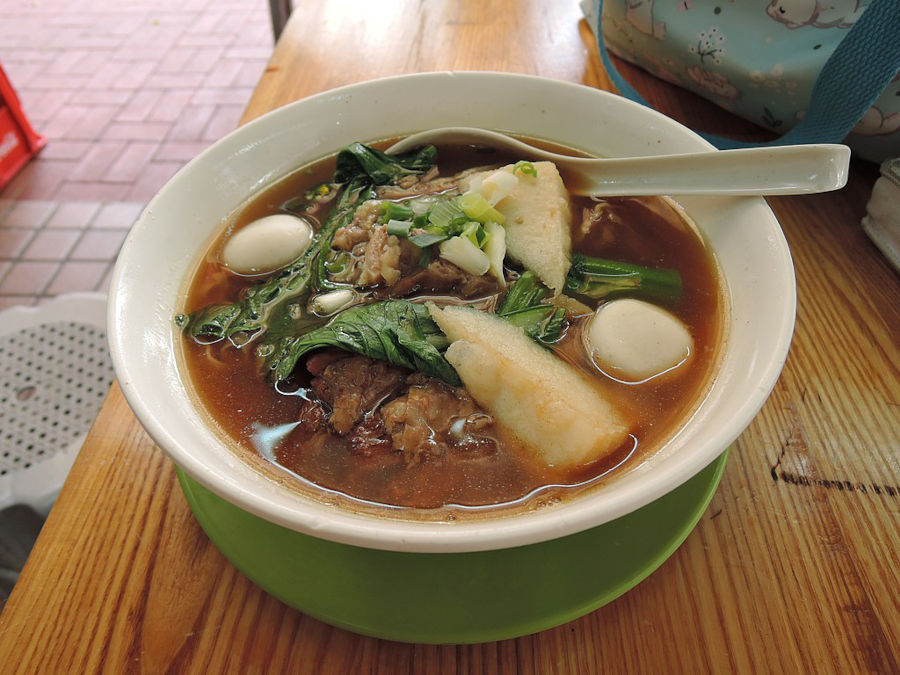
In the 1950s, noodle dishes were sold by food vendors who roamed around the city in wooden carts, hence cart noodles’ name. There are no street vendors anymore, however you can still find this staple of Hong Kong cuisine in restaurants. The speciality of cart noodles is that it allows diners the freedom to build their own bowl. Diners have the choice to mix and match soup bases, types of noodles, and toppings like fishballs, duck blood, and white radish. There’s no wrong combination!
Century Eggs (pei daan, 皮蛋)
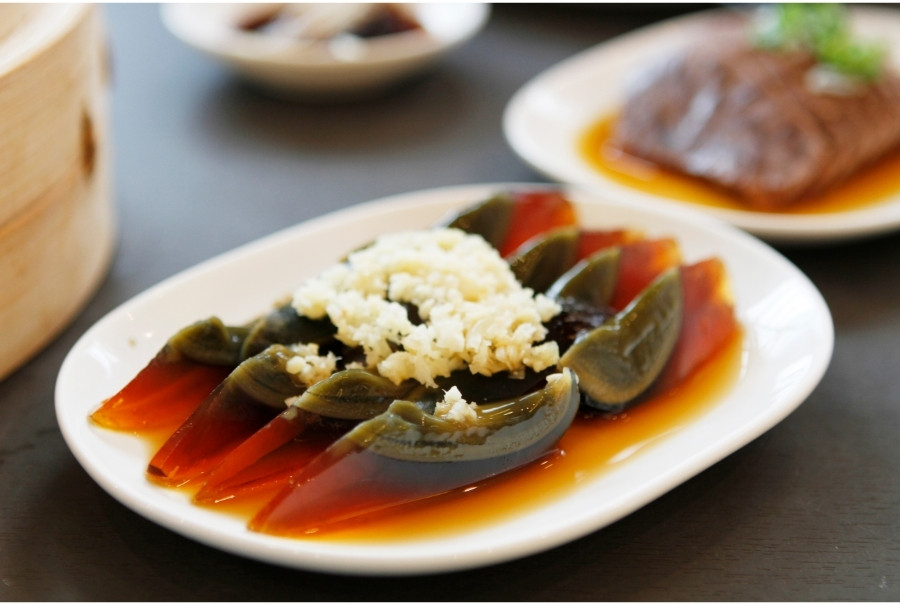
Century eggs, also called thousand year old eggs (the names are more a general emphasis on a long aging process rather than an exact period of time) are made by preserving duck or chicken eggs in a mixture of clay, ash, salt, quicklime, and rice hulls. The preservation process turns the yolk into a dark grey and greenish colour, and induces a strong flavour and creamy consistency. The egg white turns translucent dark brown with a jelly-like texture. Century eggs can be peeled and eaten directly or served as a flavourful condiment.
Chinese Tea (cha, 茶)
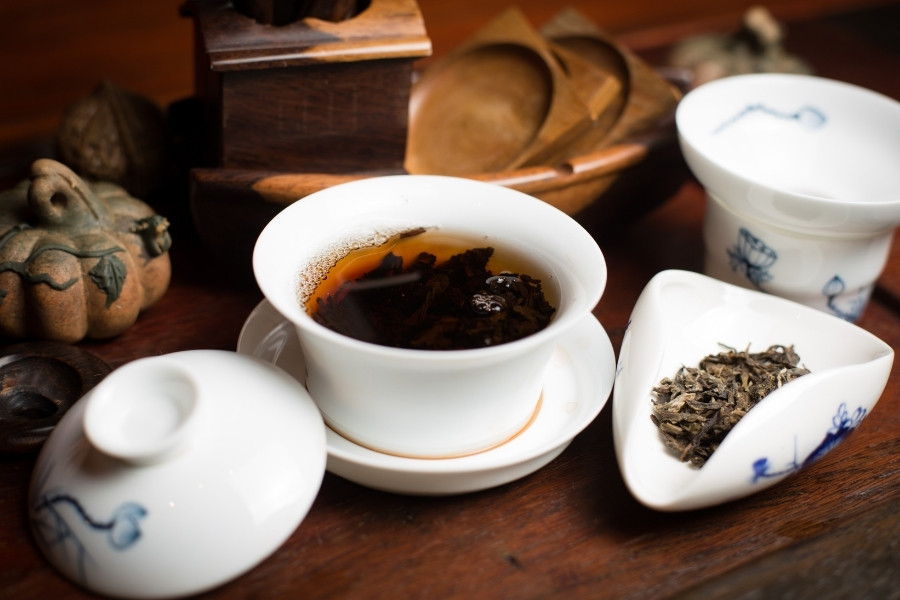
In Chinese culture, tea is considered one of the seven necessities of life. There are five basic categories of tea; green, white, oolong, black, and pu erh (post fermented). Chinese tea is rich in antioxidants and is known to have various health properties. Tea is served at most local restaurants and tea houses (called cha lou in Hong Kong), and is the perfect beverage to wash down greasy food.
Claypot Rice (bou zai faan, 煲仔飯)
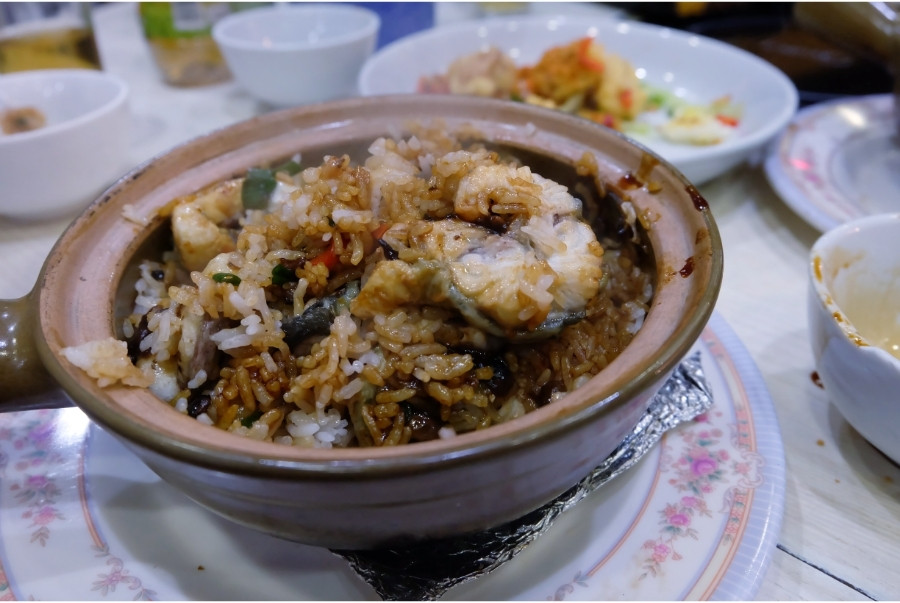
Claypot rice is served hot, making it the perfect dish to combat the cold weather. To make this much-loved Hong Kong dish, white rice is cooked in a claypot and topped with a variety of meat; chicken, pork, Chinese sausages and drizzled with a special sauce. Claypot rice is traditionally cooked over a charcoal stove, giving the claypot its signature blackened look. Mix the charred rice lining the sides of the claypot for extra texture and a smoky flavour in every bite.
Congee (zuk, 粥)
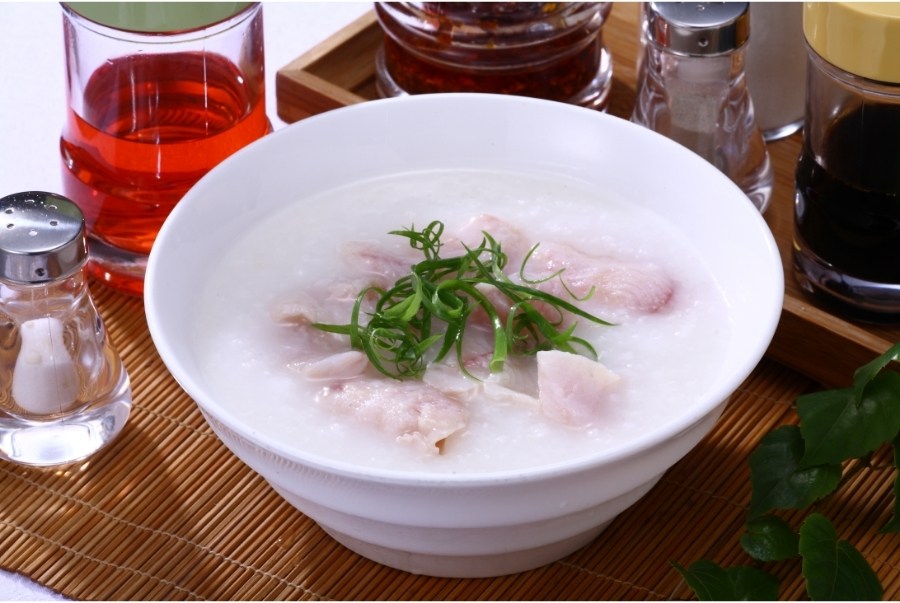
The consistency of congee is thick and silky, making it the ultimate comfort food in Hong Kong. It is also easy to eat and digest, making it a great option for sick food. It can be eaten plain or feel free to throw in any ingredients (chicken, seafood, eggs) you can find in the fridge. One of the beauties of congee is its versatility and easy cooking process. Top congee with scallion, roasted garlic bits, and ground pepper for an extra kick!
Curry Fishballs (ga lei yu daan, 咖喱魚蛋)
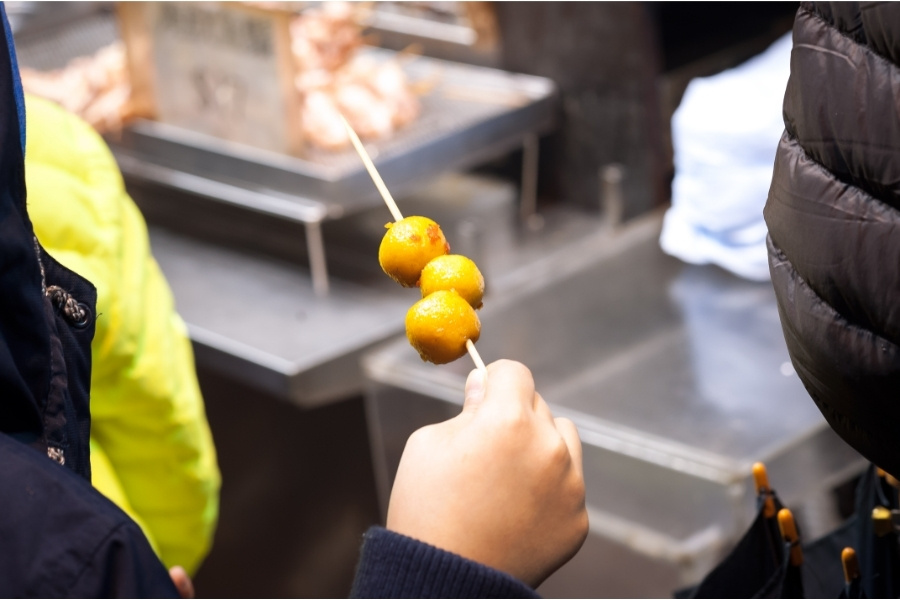
Fishballs can be found aplenty in Hong Kong, eaten from styrofoam cups, stuck onto skewers, or garnishing bowls of noodles. The popular Hong Kong street food is made from a fish paste, like grey mullet or carp, which is rolled into balls and then boiled to make it retain its shape. Before serving, the balls are usually deep-fried to a pleasing yellow colour for texture. The smooth yet absorbent resulting fishball readily grabs onto whatever condiment it’s paired with – and often that’s curry satay sauce and/or chill oil.
Dim Sum (點心)
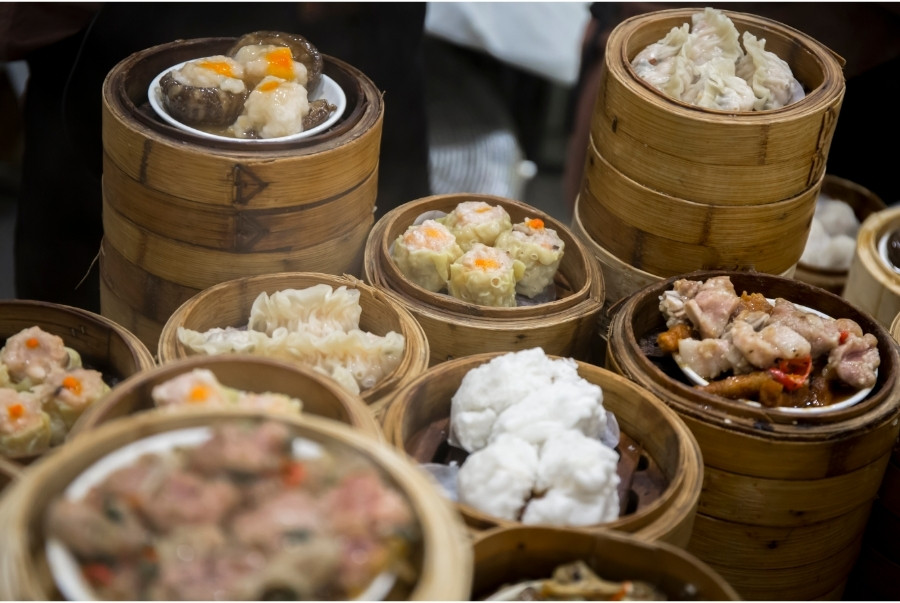
The rich Chinese food tradition of yum cha is where friends and family come together to catch up while eating dim sum, bite sized morsels and drinking tea. Dim sum can range from pork dumplings, shrimp filled wontons (har gao), to braised chicken feet.
Must-trys include:
- Har gow – Steamed fat shrimps enveloped in a translucent, chewy rice wrapper
- Siu mai – Steamed pork and shrimp dumplings wrapped in a yellow wrapper
- Char siu bao – Fluffy steamed buns stuffed with juicy chunks of barbecued pork
Egg Tart (daan taat, 蛋撻)
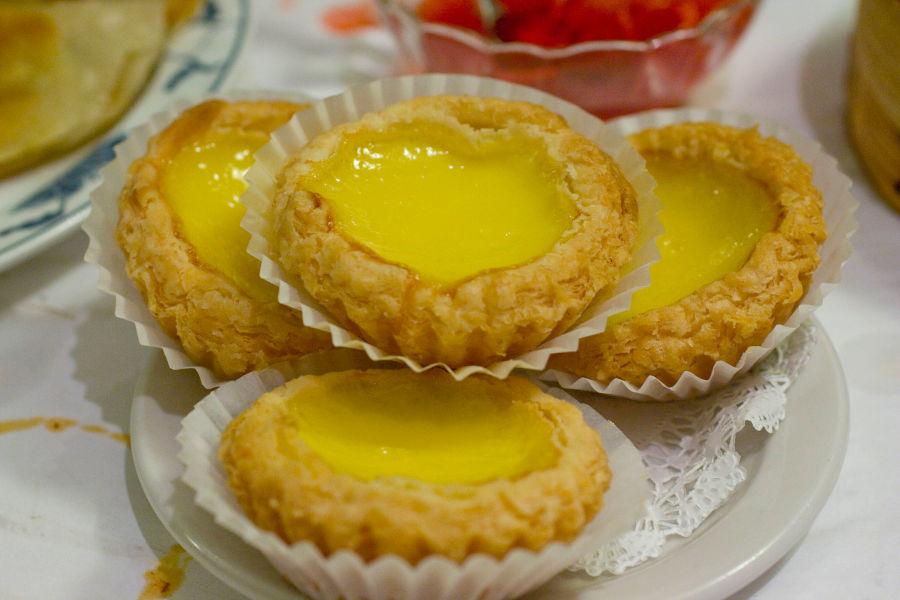
Egg tarts came to Hong Kong in the 1940s via Guangzhou, where it was created as a variation on a European custard tart sold in department stores. The outer shell is puff or shortcrust pastry, flakey and leaving a buttery film on your fingers, filled with a silky custard made of sugar, evaporated milk, water, and eggs. This is baked until it just sets. The top of this now famous Hong Kong food remains glossy and yellow – if you see a browned top, that is a Macau variation called a po taat (“Portuguese tart”).
Fried Beef Noodles (gon caau ngau ho, 乾炒牛河)
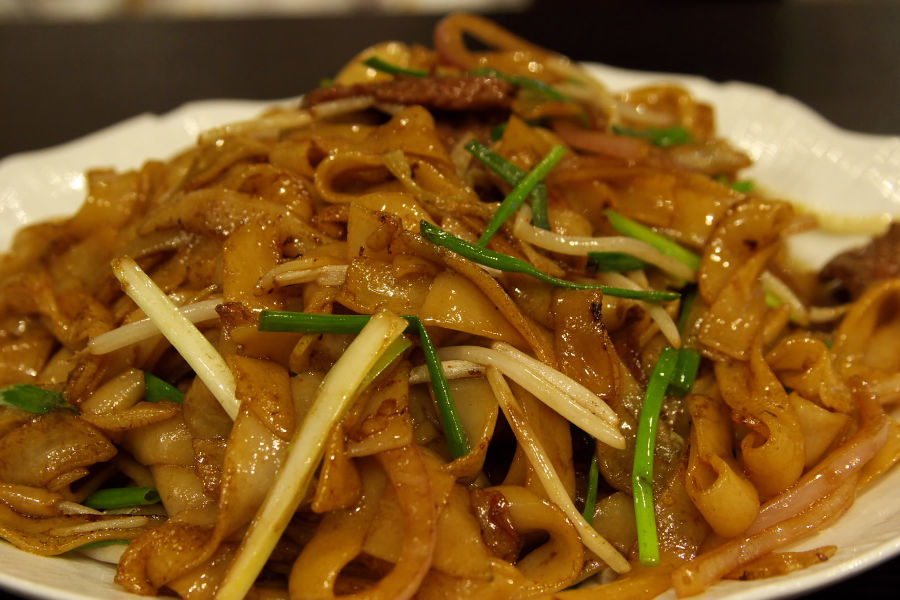
Stir-fried beef noodles is a popular Cantonese food that can be found in almost all local restaurants. This dish consists of tender beef strips, hor fun (wide rice noodles), scallions, and bean sprouts seasoned with soy sauce until the noodles are an even brown colour. This saucy, greasy delight is best eaten steaming hot off the wok.
Fried Rice (caau fan, 炒飯)
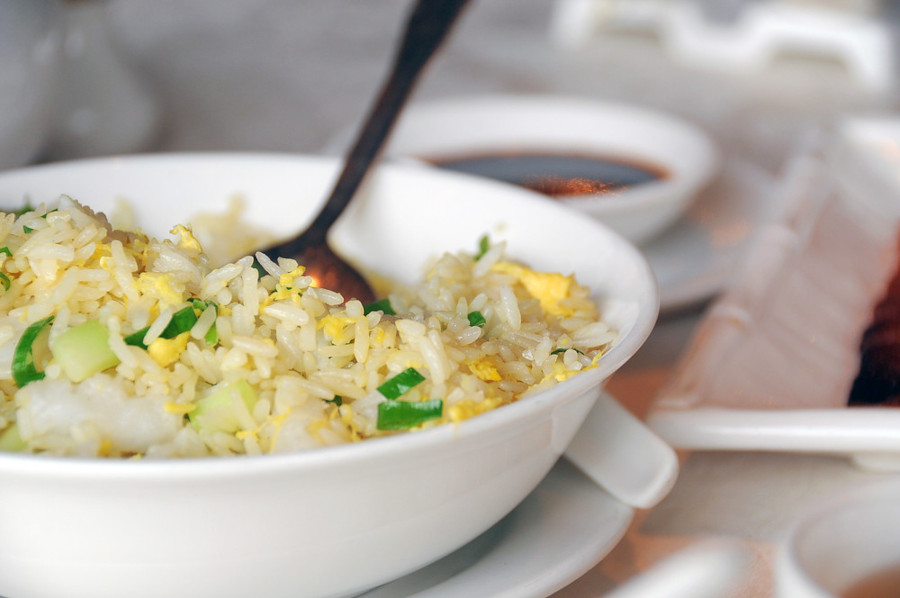
Nigel Ng’s viral Youtube video featuring Jamie Oliver went viral, throwing this staple Chinese food associated with takeout into the spotlight. There are many versions of this carby cheat meal. Cantonese Hong Kong-style fried rice consists of garlic, onion, veggies, egg, and shrimp, creating different textures. The ingredients are stir-fried on a hot wok, giving the dish a smoky aroma without overwhelming the clean flavours of the delicately balanced ingredients.
Glutinous Rice in Lotus Leaf (no mai gai, 糯米雞)
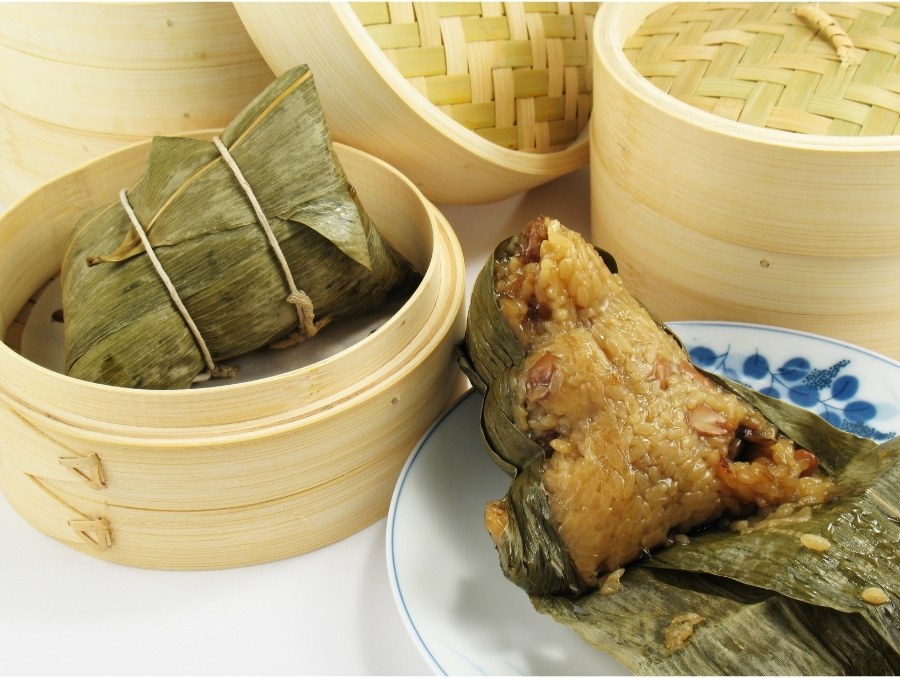
No mai gai is an aromatic Hong Kong delicacy bursting with flavour. This standalone dish can be found in any dim sum restaurant. This delicacy is a mixture of glutinous rice, meats (chicken, pork, and Chinese sausage), and sometimes a salted egg yolk drizzled with sauces. It is then wrapped and steamed in lotus leaves, until all the flavours are infused together.
Golden Prawns (gam saa ha, 金沙蝦)
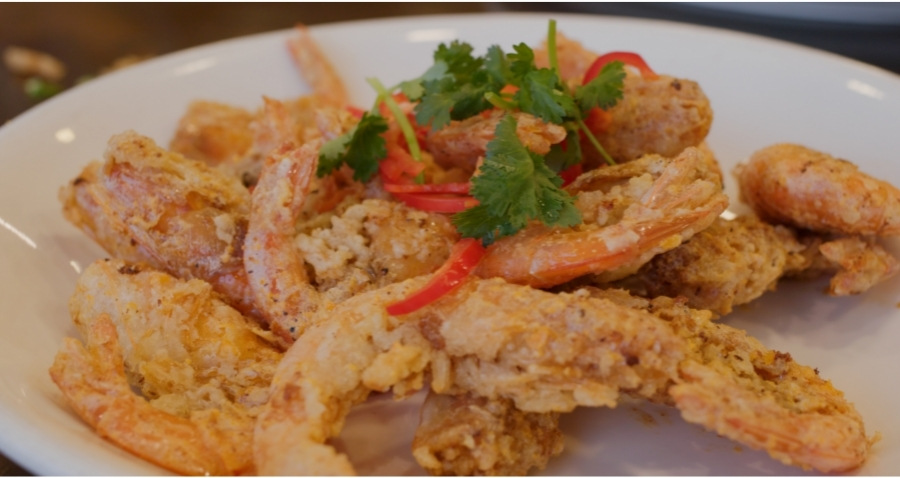
Golden prawns are a feast for the senses and is a must-order dish in Chinese seafood restaurants. The prawn or shrimp are battered and fried until crispy. It is then generously coated in salted egg yolk sauce, giving it a gorgeous golden crust. Each bite of the buttery coating reveals a salty, creamy crunch with a hint of sweetness.
Hainanese Chicken (hoi nam gaai fan, 海南雞飯)
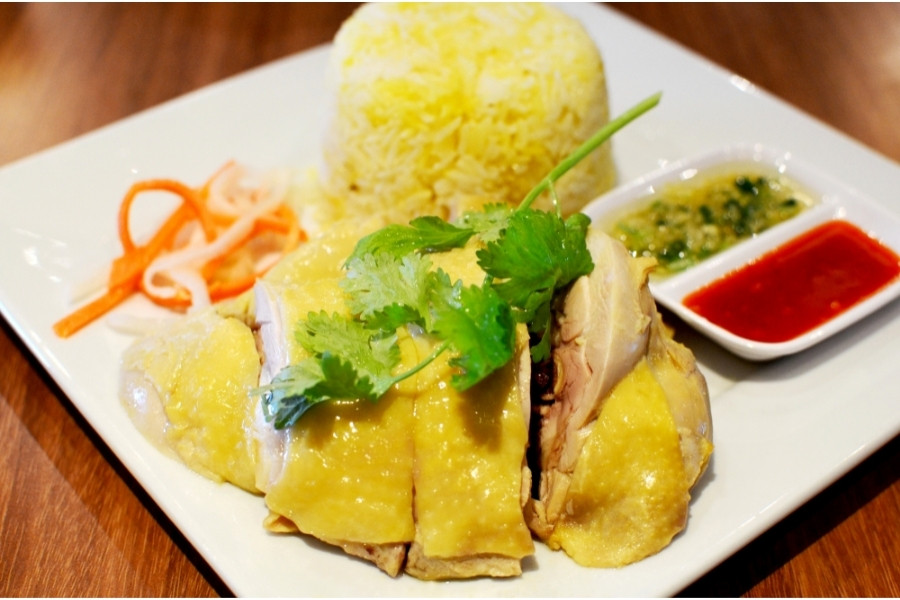
Hainanese chicken is a popular dish in many South East Asian countries. The chicken is poached, garnished with slices of cucumber and served in a sweet soy sauce. Hong Kong-style chicken rice stands out from the pack as it utilizes yellow skinned chicken for a fragrant and smoother flavour. This protein-packed dish is eaten with rice seasoned with spices and accompanied by a special chilli sauce.
French Toast (Hong Kong-Style) (sai do si, 西多士)
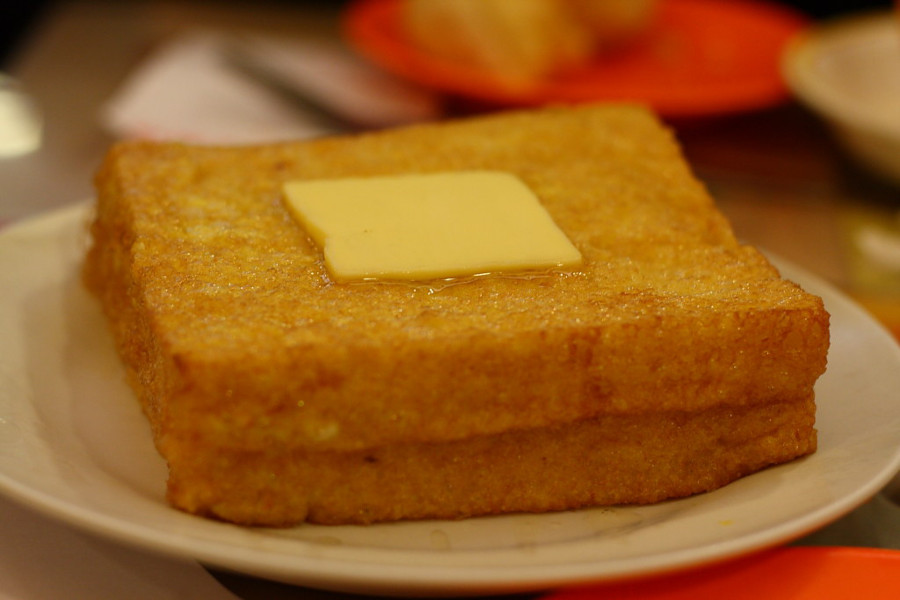
This local rendition of French toast is a unique fusion of east and west. The bread is drenched in egg mixture, stuffed with fillings such as peanut butter or Nutella and deep-fried until golden. It is then topped with a fat cube of butter and syrup or condensed milk is drizzled on top. If you can’t tell, this indulgent dessert is definitely not breakfast food, but most common at afternoon tea time!
Hot Pot (daa bin lou, 打邊爐)
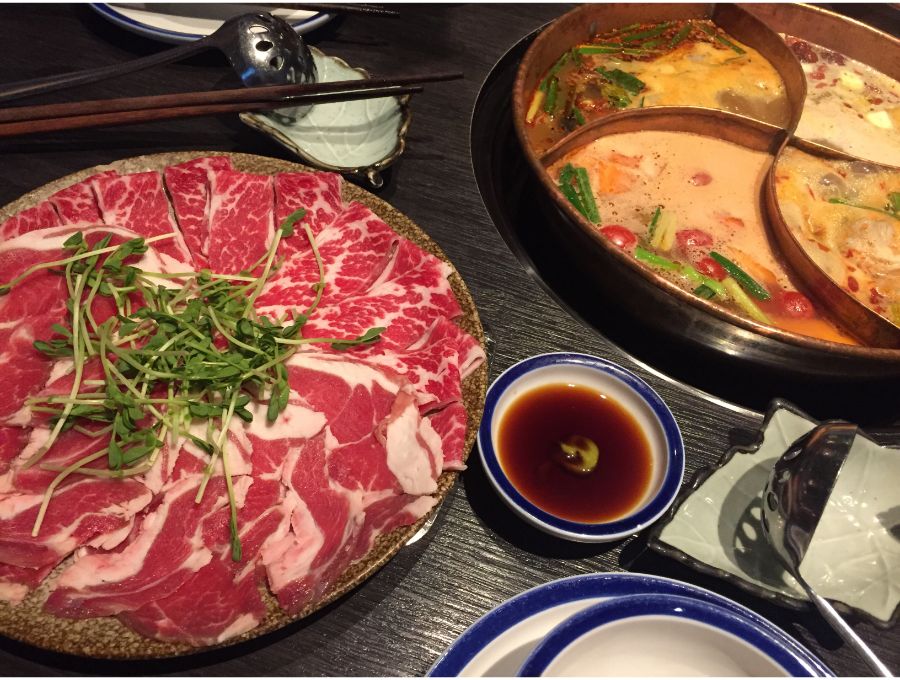
The moment the weather starts getting cooler, Hongkongers start organizing hot pot get-togethers. Hot pot is a flavourful broth that is brought to a boil and left to simmer for the duration of the meal. Friends and family gather around the pot and put in raw ingredients such as vegetable, fish cakes, and meats. Get creative and concoct your own dipping sauces! Our favourite: Dip your cooked food in soy sauce mixed with scallion fried garlic for an extra burst of flavour.
Iced Lemon Tea (dong ning caa, 凍檸茶)
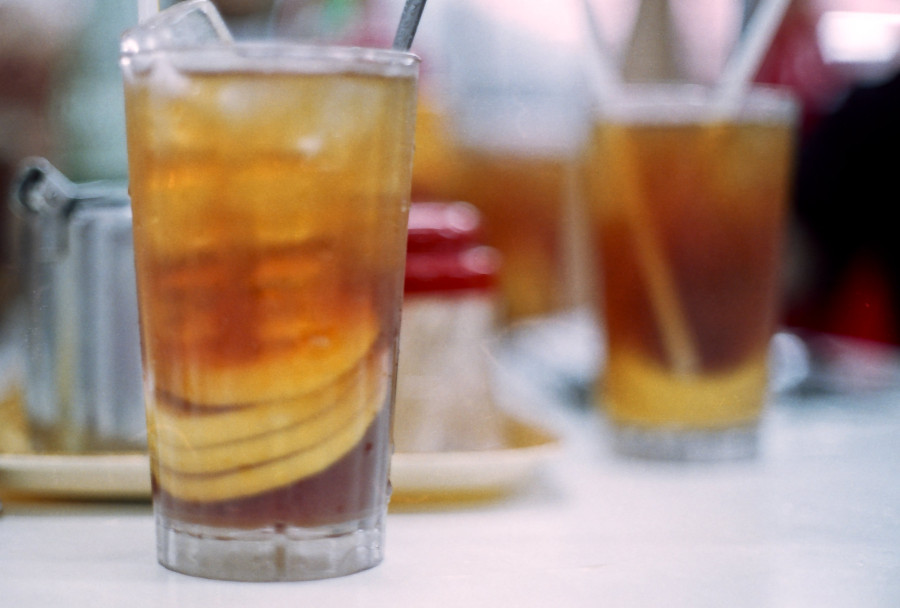
Summers in Hong Kong are hot and humid. There is only one sure-fire way to quench your thirst during these times. This drink consists of tea, water, lots of ice, and is garnished with slices of lemon. Just kick your heels back at a local cha chaan teng or restaurant and sip Hong Kong-style iced lemon tea during summer.
Instant Noodles (gung zai min, 公仔麵)
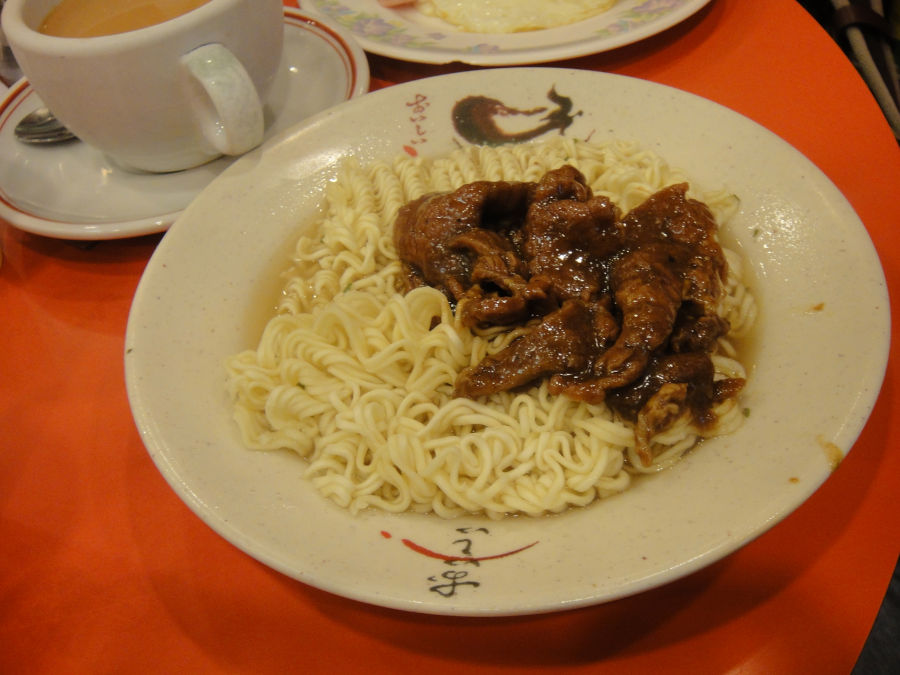
Instant noodles are an inexpensive and quick breakfast food in Hong Kong cha chaan tengs (a kind of tea café) that is rife with history. The instant noodle is decorated with slices of spam and a sunny side up egg. Although this dish is simple, it is a tasty, filling breakfast to kickstart your day.
Macaroni Soup (tung fan, 通粉)
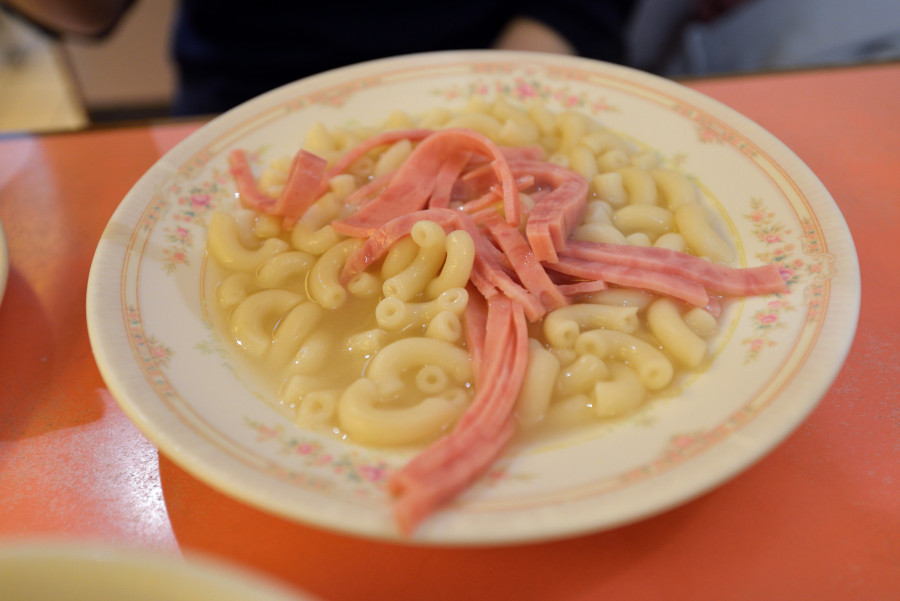
Breakfast is the most important meal of the day. Macaroni soup is a staple Hong Kong breakfast dish. It consists of macaroni in soup topped with strips of ham. Popular soup base options are tomato soup, clear soup, and satay beef soup. Pair the soup with buttered toast and a hot cup of milk tea for an authentic local breakfast.
Mango Pomelo Dessert (joeng zi gam lau, 楊枝甘露)
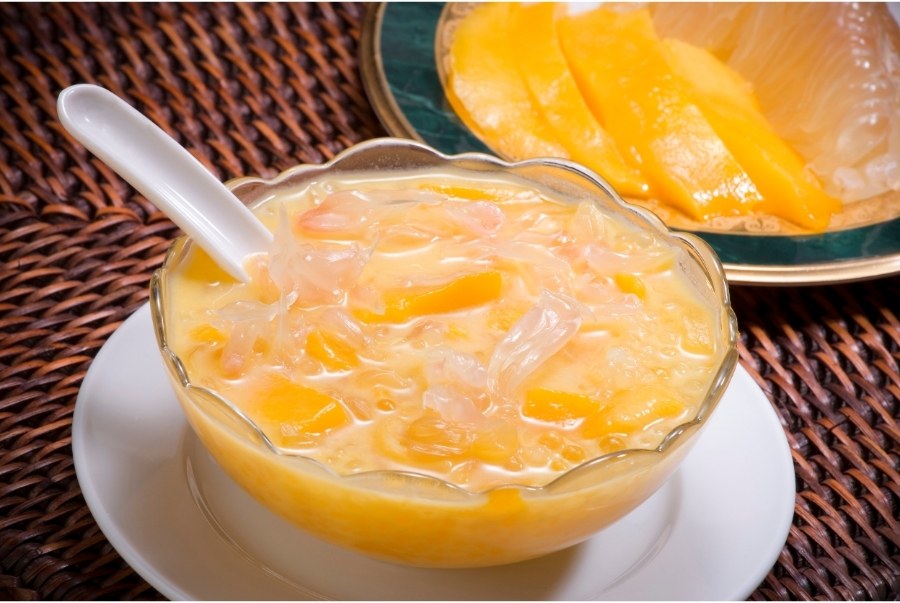
This childhood favourite is the perfect way to combat summer heat waves. This refreshing dessert consists of chunks of mango, pomelo, and sago pearls swimming in an icy, creamy soup of evaporated milk and coconut milk. This fruity delight is sweet with just a hint of tanginess from the fruit and is guaranteed to make your day better!
Milk Tea (lai cha, 奶茶)
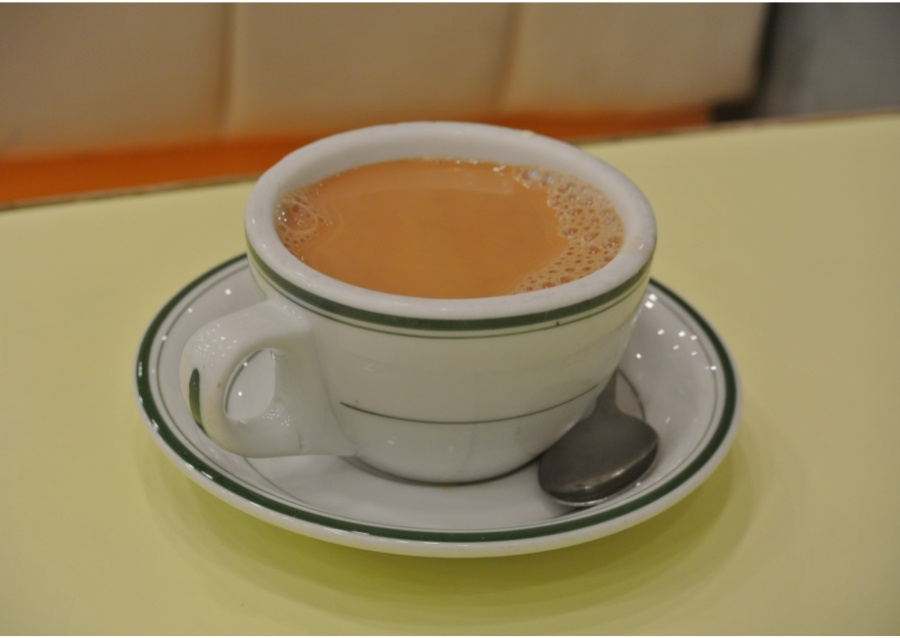
Stocking milk tea, made by streaming black tea through a fine stocking and then adding evaporated milk, makes Hong Kong’s classic creamy milk tea. Alternatively, if you can’t decide between coffee and Hong Kong style milk tea, try yuen yeung. This delicate balance of tea and coffee gives you the best of both worlds. Yuen yeung is made with a three to seven part ratio of coffee to milk tea, giving you a creamy, caffeinated boost to start your day. Yuen yeung can be served hot or cold and can be found in most local restaurants.
Osmanthus Jelly (gwai fa gou, 桂花糕)
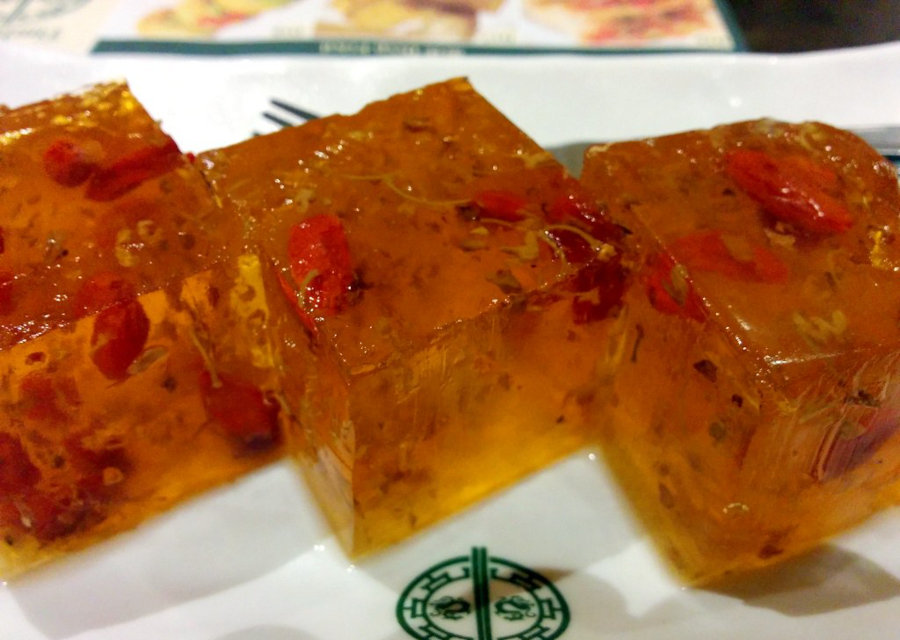
Osmanthus jelly has a beautiful crystal-like appearance and is studded with goji berries and osmanthus flower petals. Served chilled, the floral scent from the osmanthus flowers and the subtle tartness from the goji berries make this the perfect dessert after a hearty meal of dim sum.
Peking Duck (bak ging tin aap, 北京填鴨)
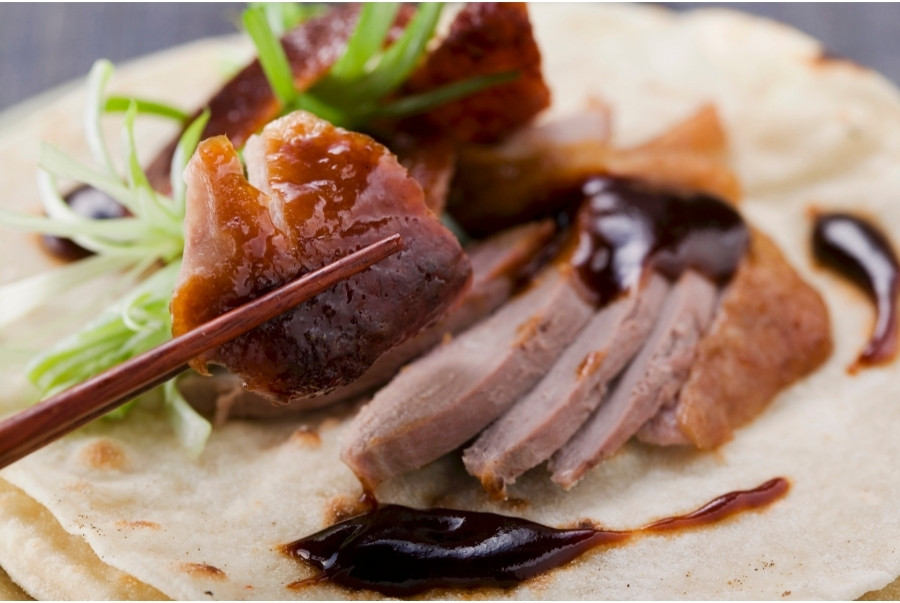
Peking duck has its roots in Beijing and used to be a dish prepared exclusively for royalty. This delicacy is highly sought after for celebratory occasions. Whole duck is roasted in wood fired ovens, rendering the fat and leaving crispy skin. Thin shavings of crispy skin and meat are sliced to the perfect amount of thickness in front of you. It is served with mandarin pancakes (thin pancake made from flour, salt, and boiling water) and accompanied by condiments such as spring onion, cucumber, and a variety of sauces. Get creative and wrap your roll just the way you like it!
Pineapple Bun (bo lo baau, 菠蘿包)
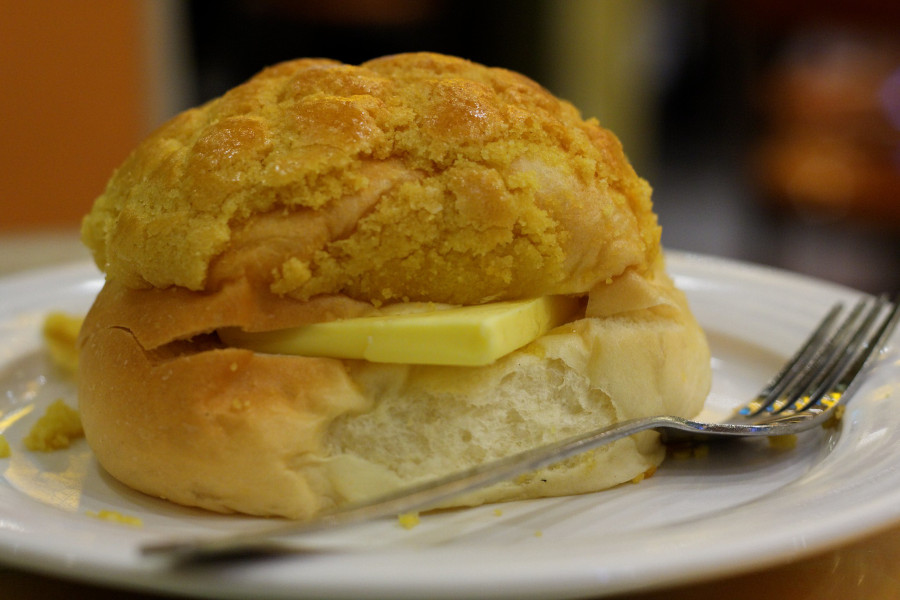
Pineapple buns are so named because of the cracked appearance of their crust, which mimic the grid-like appearance of pineapple rinds. They are made up of a soft, slightly sweet typical local style bread topped with a sugar cookie-like layer that turns golden and splits apart pleasingly when baked. At cha chaan tengs, pineapple buns are often served hot out of the oven with a thick slice of butter in the middle that’s just starting to melt. This is called, in the Cantonese fashion of shortening phrases, bo lo yau, or ‘pineapple butter’.
Red Bean Soup (hung dau saa, 紅豆沙)
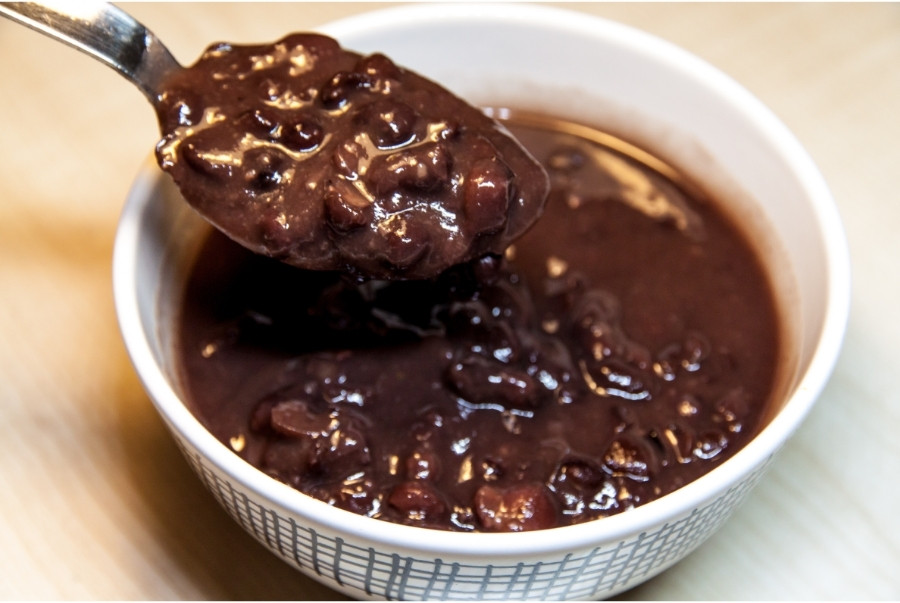
Red bean soup is a popular dessert in China, Taiwan, and Southeast Asia. The texture and consistency of the dessert varies with different recipes, but in our opinion, Cantonese-style red bean soup stands out from the rest. This dessert consists of red beans boiled with rock sugar until the red beans disintegrate to the point that it is thick, creamy, and almost sandy. Wondering what’s the secret ingredient to the tangy twist? Tangerine peel!
Rice Rolls (cheung fun, 腸粉)
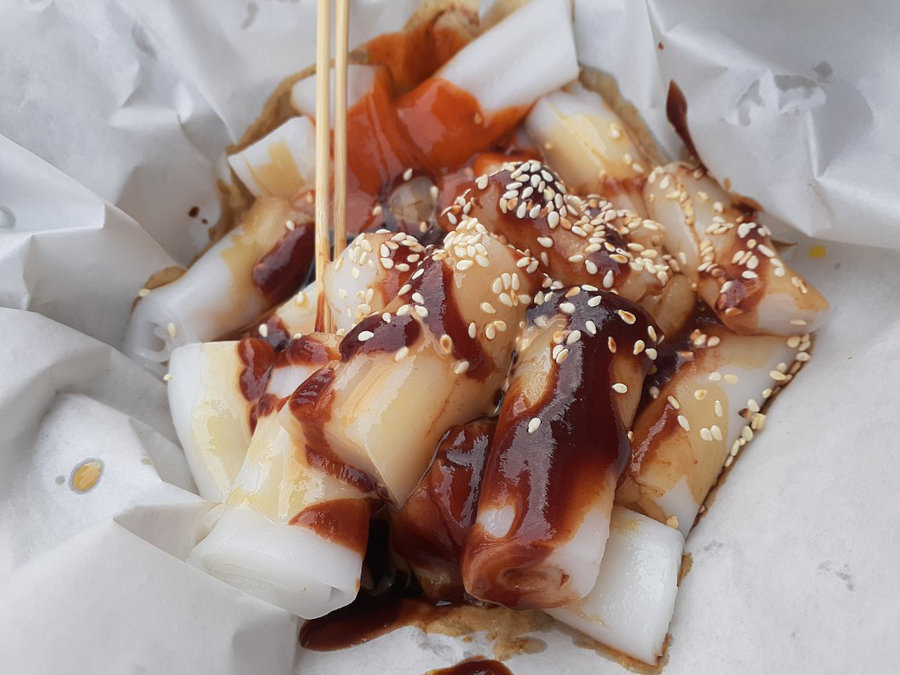
Rice rolls have an iteration in each Asian culture. In Hong Kong, the way you’ll see rice rolls presented in street food stalls is prepared like this: steam a mixture of rice flour, starch, and water, carefully roll the delicate sheet into cylinders, drown in peanut sauce, hoisin sauce, sweet chilli sauce if you want some spice, and sesame seeds. This is cut into bite-size pieces. Rice rolls are also served with shrimp, beef, or pork inside at tea houses.
Roasted Chestnuts (chaau leut ji, 炒栗子)
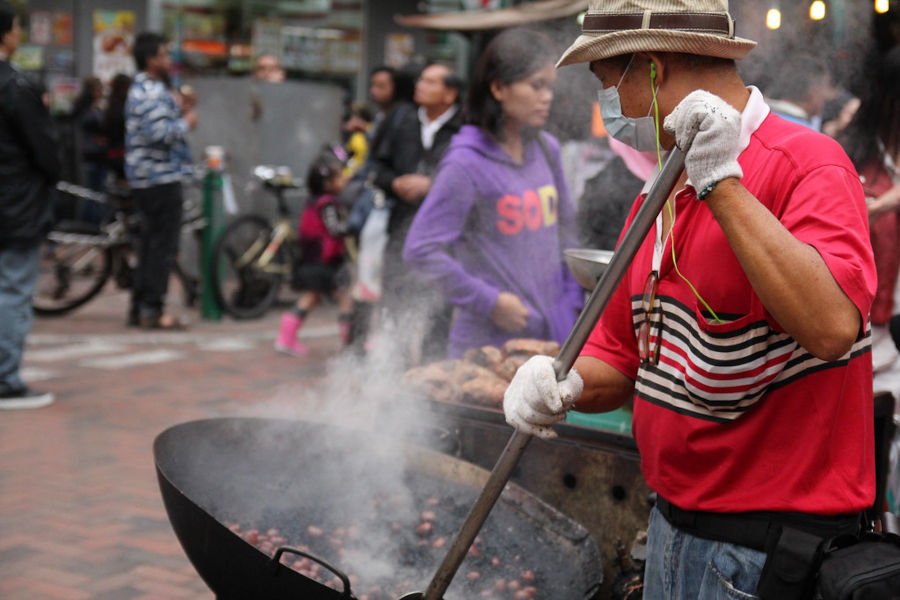
Roasted chestnuts are a beloved winter tradition of Hong Kong food. The moment the weather starts to cool, chestnut vendors can be found wheeling their carts along the streets of Hong Kong. The comforting smell of sweetness and coals waft through the air as vendors roast chestnuts on a huge wok. Roasted chestnuts are the perfect snack to warm you up.
Roasted Goose (siu ngo, 燒鵝)
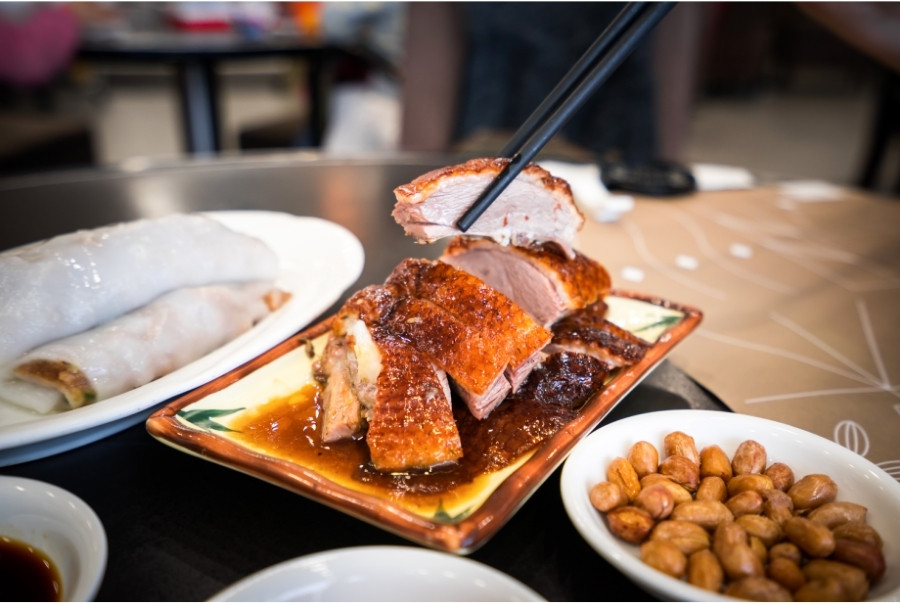
Leaving Hong Kong without trying roasted goose is like going to Paris without seeing the Eiffel Tower. Goose is marinated in a blend of spices, then roasted using charcoal and doused with sizzling hot oil until the skin is perfectly crispy. The meat is succulent and juicy. It is often accompanied by a bowl of noodles or rice.
Roasted Pigeon (siu yu gap, 燒乳鴿)
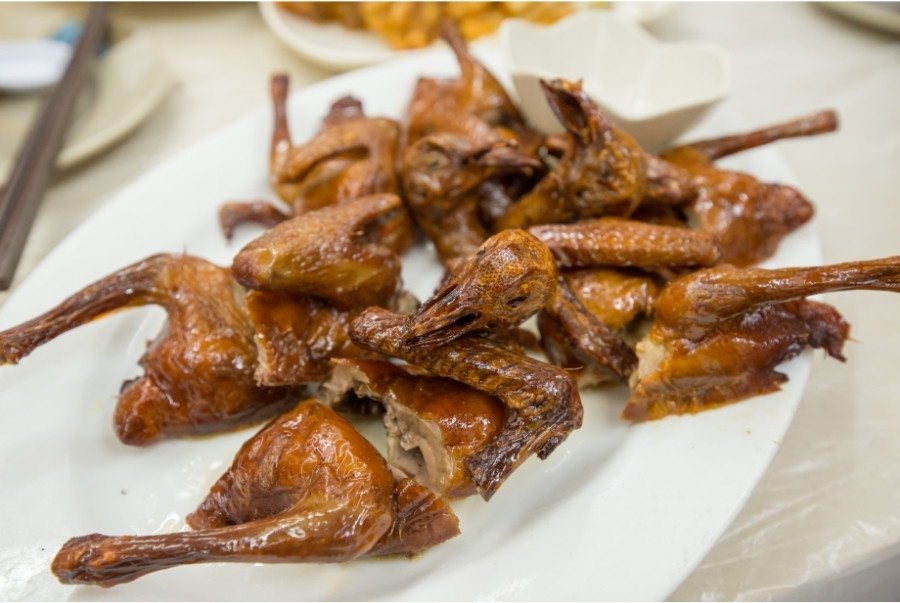
Roasted pigeon is a Hong Kong classic and is a symbol of prosperity and auspiciousness in Chinese culture. It used to be only eaten during festivals, however you can find it in siu mei shops (restaurants specialising in roasted meats) now. The pigeon is submerged and braised in a mixture of Chinese spices so the taste penetrates the meat. It is then deep fried until it’s a deep amber colour. The skin is crispy and the meat is succulent. In fact, some people say that roasted pigeon is more flavourful than roasted duck!
Roasted Pork (siu yukh, 燒肉)
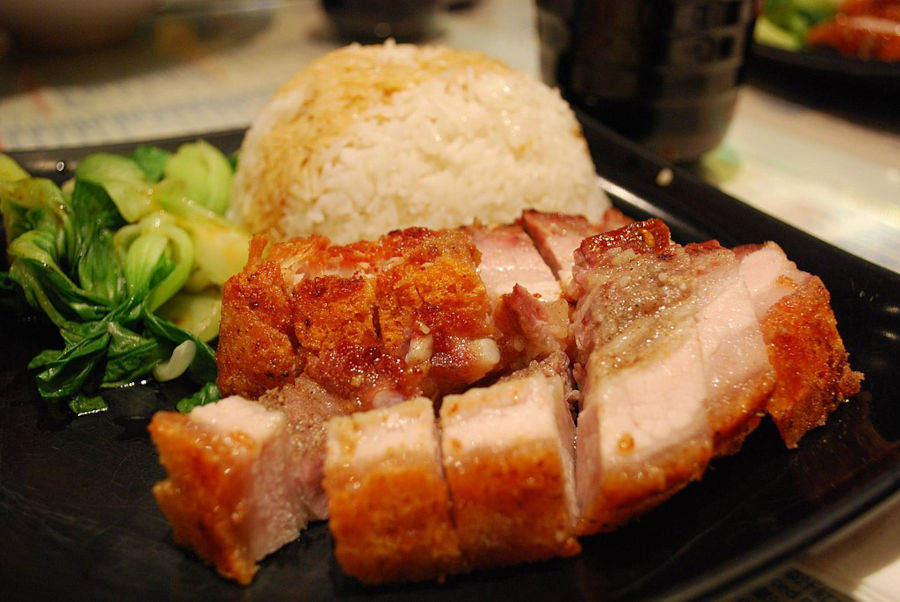
Roasted pork is another type of siu mei, or roasted meat dish in Cantonese cuisine. Slabs of pork belly are seasoned and roasted at a high temperature until the skin is bubbling and crispy. The secret ingredient- high fat to meat ratio. Get a mouthful of crispy, juicy meat and melt-in-your-mouth fat. This dish is delicious on its own, but better with a bowl of steaming hot rice.
Stuffed Three Treasures (zeen yeung sam bo, 煎釀三寶)
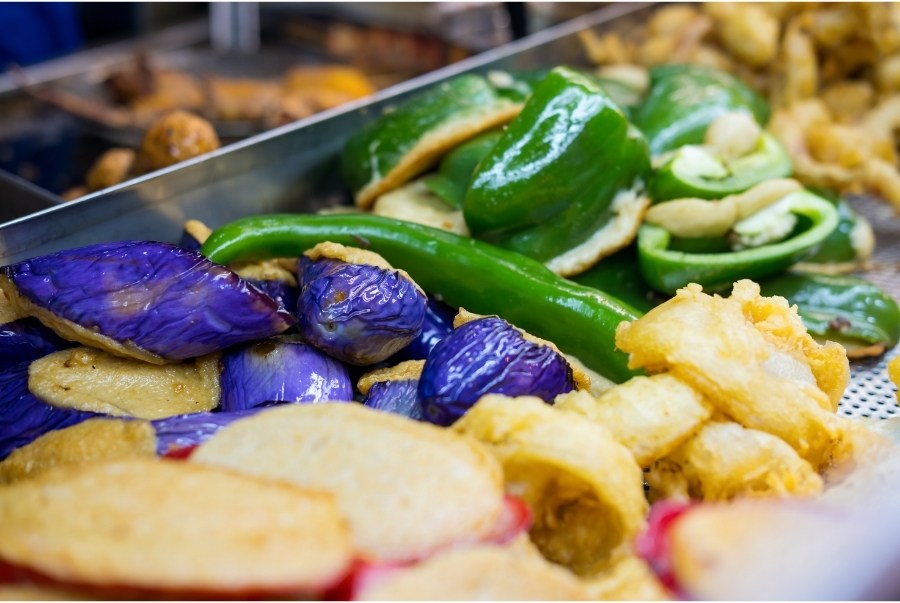
Hong Kong is a street food heaven. One of the most popular street foods are vegetable slices smeared with carp or shrimp paste, which are then fried. The “three treasures” refer to the three most popular items – green bell pepper, aubergine (also called eggplant), and sliced red sausage, however, there are other stuffed options too. This Hong Kong snack may be greasy, but with vegetables in the mix, how unhealthy can it be?
Snake Soup (she geng, 蛇羹)
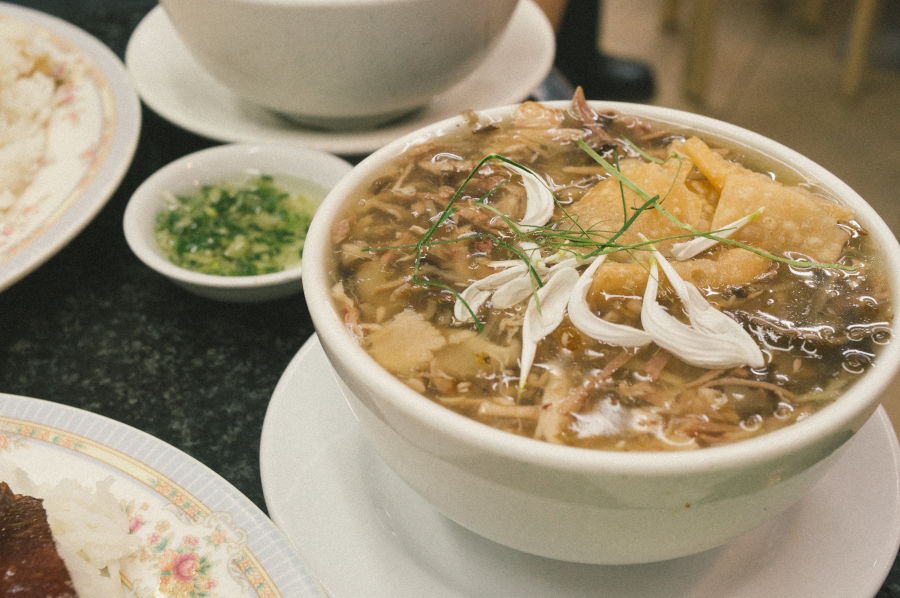
Snake soup has a rich history of up to 2,000 years. In Chinese tradition, eating snake soup is a symbol of wealth, bravery, and respect. This Chinese delicacy has a ton of medicinal properties and is popular during winter. Snake soup contains the meat of two kinds of snakes as the main ingredient. The soup has a tinge of sweetness due to the addition of Chinese spices and chrysanthemum flowers.
Soup Dumplings (siu lung baau, 小籠包)
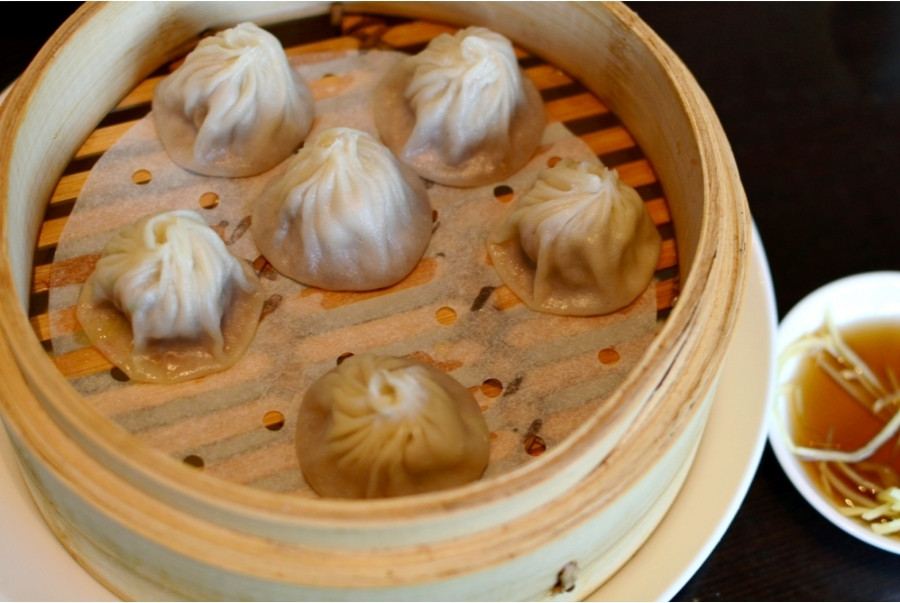
Soup dumplings refer to steamed buns prepared in a small bamboo basket, xiao long, giving the dish its name in Putonghua: xiao long bao. These buns are filled with pork and contain a gelatin called aspic. As it’s steamed, the aspic melts, revealing a flavourful broth as you bite into the soup dumpling. This tasty morsel is accompanied by vinegar and ginger slivers for an extra dimension of flavour.
Steamed Fish (ching jing yu, 清蒸魚)
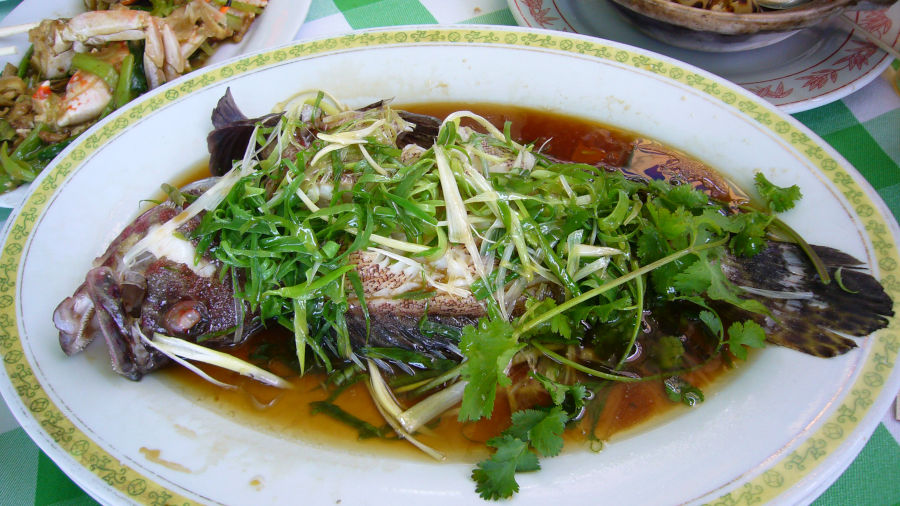
Steamed fish is a deceptively humble dish. However, it is extremely tasty and in Chinese culture, it is a sign of auspiciousness, making it a popular dish during celebratory occasions. To accentuate the freshness of the fish, Hongkongers use minimal condiments to ensure that the taste of fresh fish shines through. The fish is steamed lightly, then served with soy sauce, scallions, cilantro, and ginger slivers.
Steamed Milk Dessert (soeng pei naai, 雙皮奶)
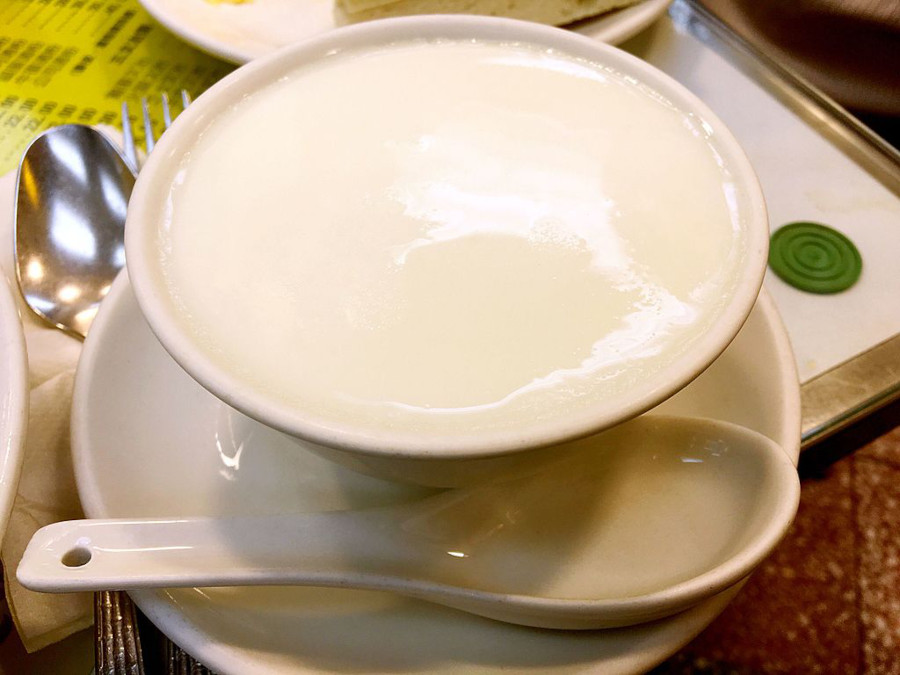
Steamed milk is light and silky smooth, resembling a creamy tofu pudding. It is made of purely sweetened milk through a complex process of boiling and steaming. Steamed milk dessert is believed to be nutritious and good for the skin. It is a versatile dish and can be a refreshing dessert in summer or a hot snack in winter.
Sweet and Sour Pork (gu lou yuk, 咕噜肉)
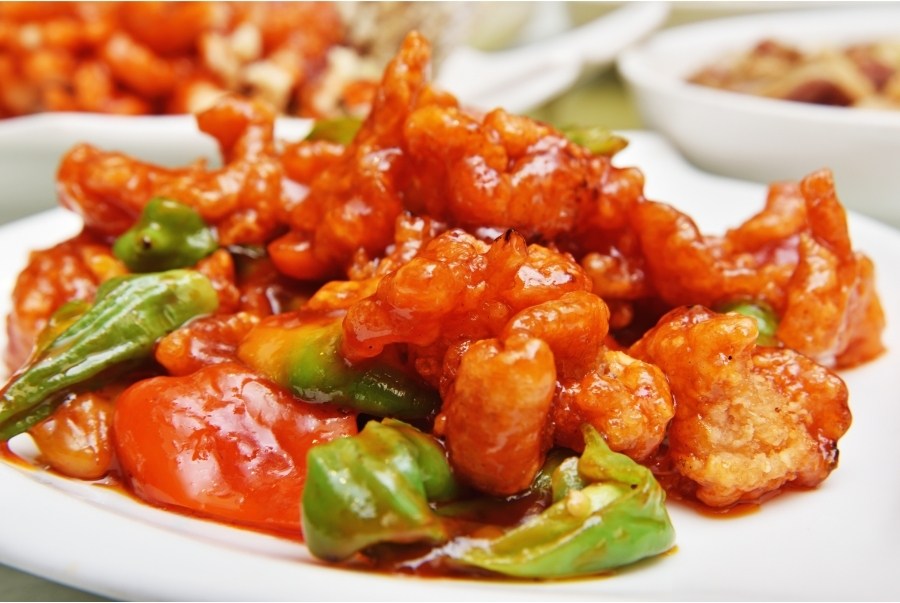
Sweet and sour pork is one of the most iconic Cantonese dishes. In fact, it is so popular that it is a staple in Chinese restaurants all around the world. Bite-sized pieces of pork are coated in a batter and deep fried. After that, they are stir fried in a sweet, tangy sauce, bell peppers, onions, and pineapples, giving the dish its signature orange glaze.
Beancurd & Pork Rice (dau fu fo naam fan, 豆腐火腩飯)
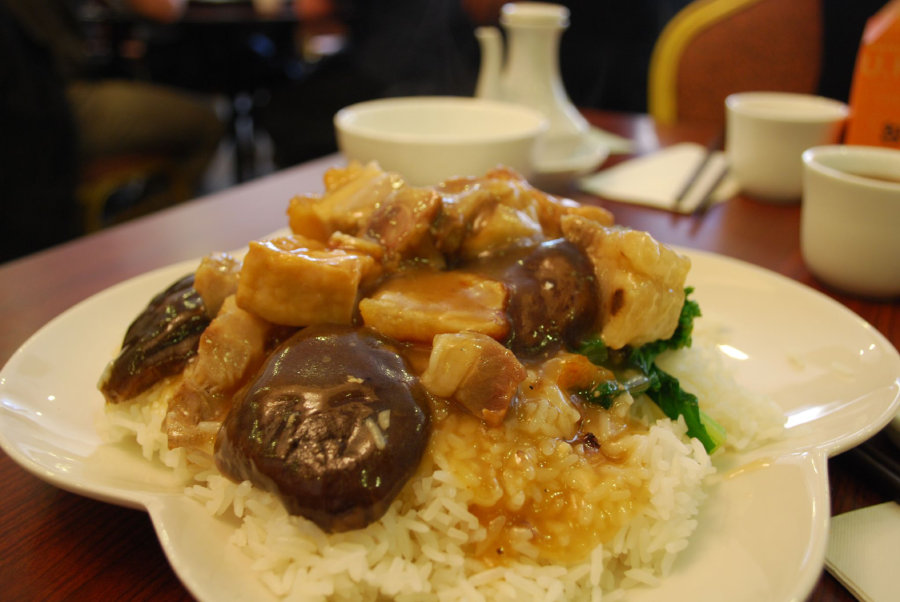
Want a more balanced dish? Braise a pot of tofu and add roasted pork as it’s prepared in Cantonese Hong Kong food to turn it into a whole new dish. Be warned, the roasted pork may lose its crispiness, however, it gives the dish a smokey flavour. Let the rice soak up the sauce for extra taste.
Tofu Pudding (dau fu fa, 豆腐花)
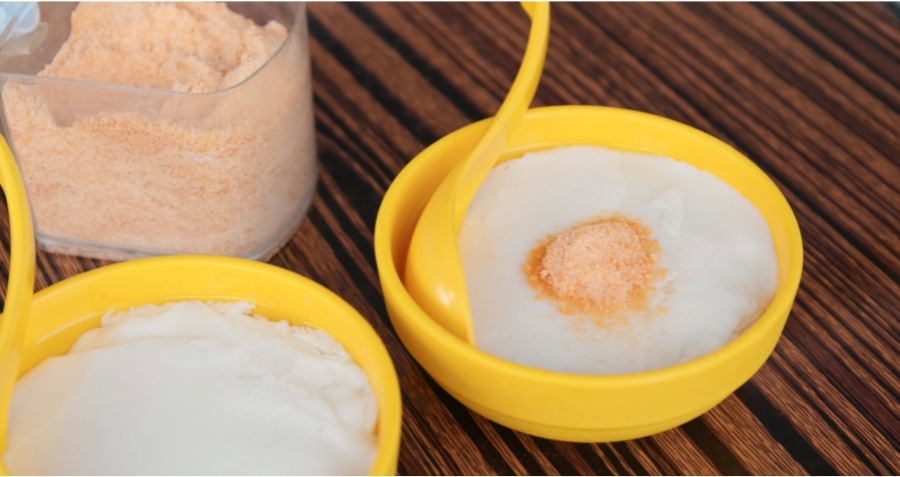
Tofu pudding is a celebration of high quality tofu – with a delicate soy flavour and silky texture that remains firm enough to spoon up achieved by coagulation. Soy beans are soaked until they’re soft, grounded and blended with water to make soy milk, filtered to remove any fibres, boiled, and then combined with gypsum powder to make it set. The jiggly tofu is then spooned out with a wide spoon, creating the layers of tofu pudding. This Hong Kong snack or dessert can be served hot or cold. Although the tofu has a slight sweetness, most people prefer to add cane sugar or ginger syrup.
Typhoon Shelter Crab (bei fung tong haai, 避風塘炒蟹)
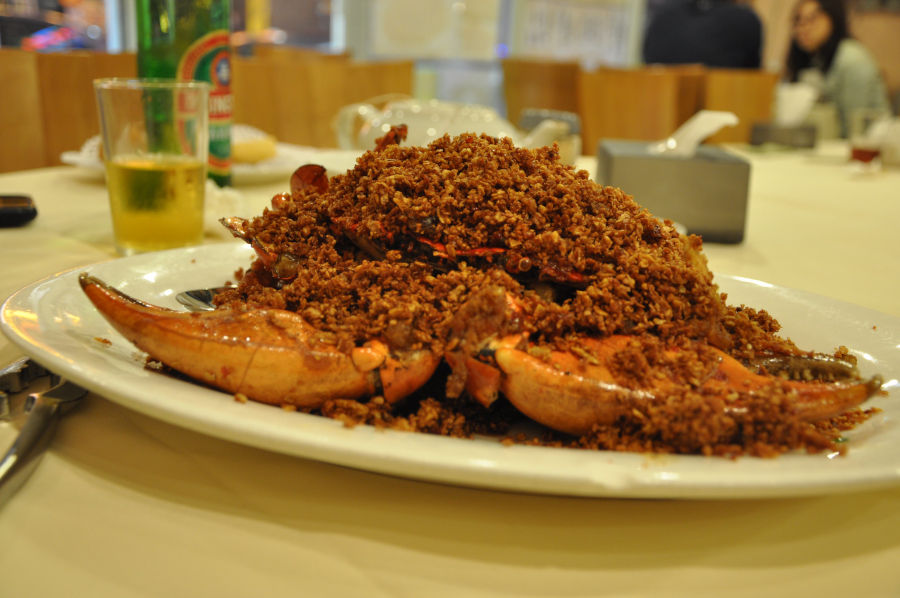
As a former haven for fishing communities, Hong Kong cuisine has strong roots in seafood. Typhoon shelter crab’s name is derived from the fact that the dish used to be served on small fishing boats that took refuge in typhoon shelters. Meaty crabs are fried with generous amounts of minced garlic, fermented soybeans, chilli pepper, and lemongrass. A word of warning: the fried garlic topping is dangerously addictive!
Steamed Vegetables (choy sum, 菜心 / bok choy, 白菜)
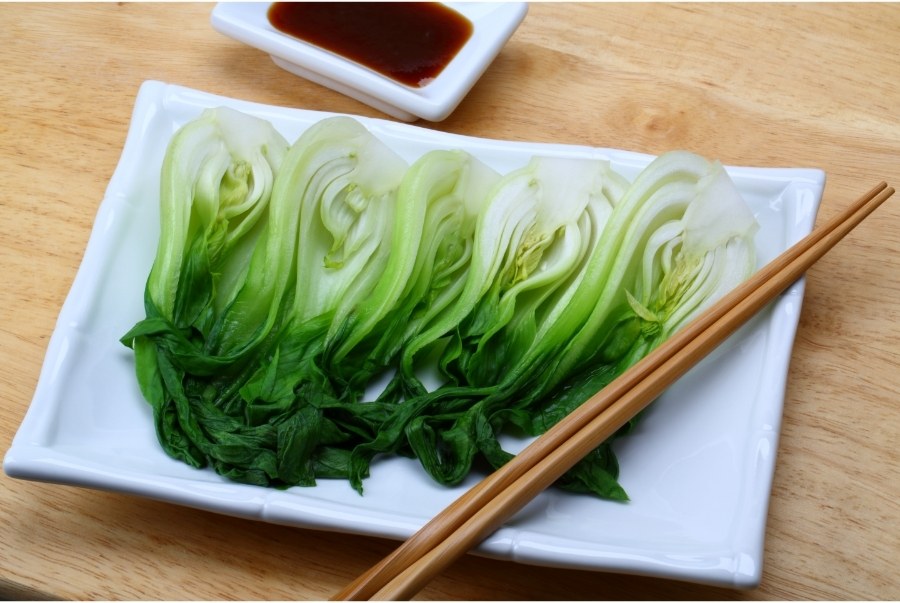
Choy sum and bok choy are popular vegetables in Chinese cuisine. The vegetables are prepared in a simple manner to accentuate their inherent light sweetness, often steamed and topped with oyster sauce. Oyster sauce is sweet and fragrant with a touch of umami, and is a popular way to elevate a dish.
Wonton Noodles (wahn tan mihn, 雲吞麵)
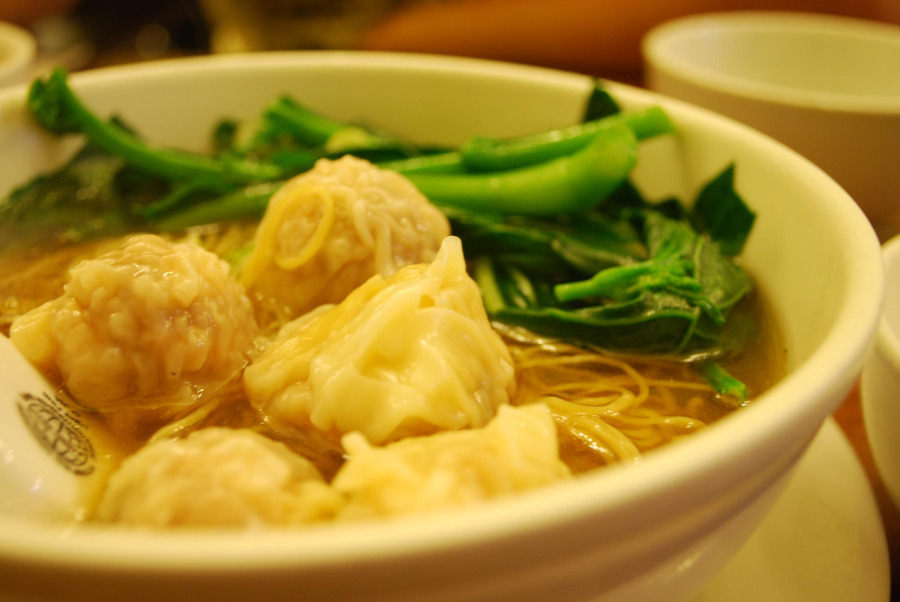
Wonton noodles are a hearty meal of thin, springy egg noodles served in a clear broth topped with chives. The bowl is decorated with shrimp and pork dumplings, however, true-blooded Hongkongers will claim that pork wontons are superior. Here’s a tip: eat the noodles first so they don’t get too soggy, and then savour the dumplings!
Header image credits: Leung Cho Pan via Canva


